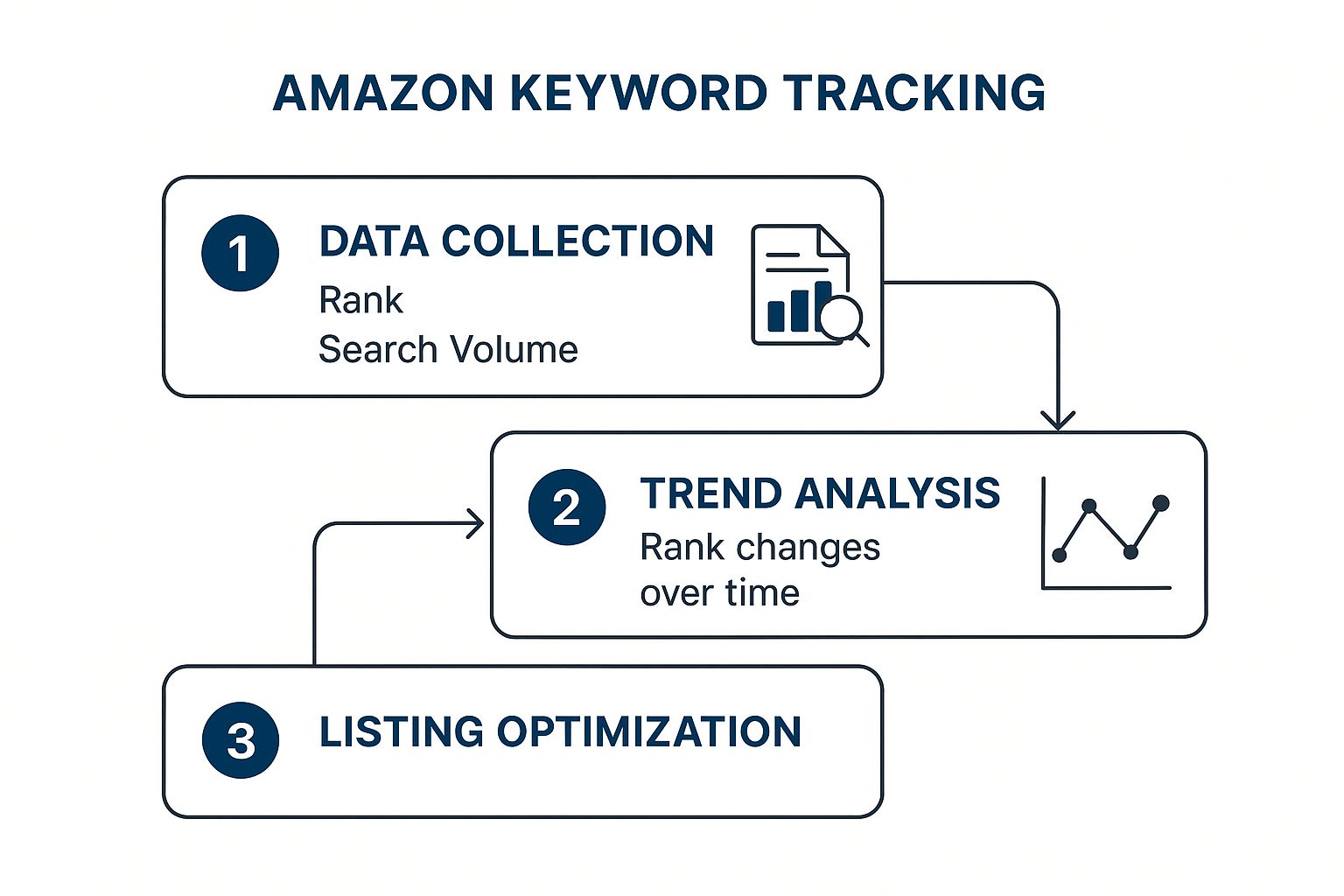Keyword Tracking on Amazon: A Guide to Driving Profitable Growth
Learn effective keyword tracking amazon strategies to improve rankings, connect PPC, and drive organic growth. Master your niche today!

Amazon keyword tracking is more than an SEO chore; it's the command center for your entire growth strategy. It's about connecting your ad spend to organic performance and making data-driven decisions that impact your bottom line. For eCommerce leaders, mastering this isn't just about watching ranks—it's about turning visibility into a predictable, profitable, and scalable asset.
Why Amazon Keyword Tracking Is a Critical Growth Lever

With over 63% of product searches starting on Amazon, the platform is one of the most powerful search engines on the planet. A static, "set it and forget it" keyword list is a recipe for failure. The marketplace demands a dynamic, performance-first approach to keyword strategy, driven by a deep understanding of Amazon's A10 algorithm.
The A10 algorithm isn't just matching keywords; it's a conversion-obsessed system. It weighs sales velocity, click-through rates (CTR), and conversion data to determine the single best product for a customer's query. This is precisely where your paid advertising becomes a direct lever for organic growth.
Connecting Ad Spend to Organic Rank
The most common mistake brands make is siloing their PPC and SEO strategies. On Amazon, they are inextricably linked. A well-executed Sponsored Products campaign is not just a short-term sales driver; it's a direct feed of positive performance data to the A10 algorithm.
Here’s the performance loop:
- Boosts Sales Velocity: Ads generate sales for a target keyword, signaling to Amazon that your product is a relevant, high-converting match. One brand, for example, saw a 30% lift in organic rank for a key term after a two-week targeted PPC push increased its daily sales velocity by 50 units.
- Improves Conversion Signals: A successful ad validates that your primary image, title, and price resonate with shoppers. The algorithm rewards listings that convert, which can lift your organic placement.
- Validates Keyword Viability: PPC is the ultimate testing ground. You can determine a keyword's actual conversion potential within days, avoiding months of wasted effort trying to rank organically for a term that doesn't drive sales.
This synergy creates a powerful flywheel: strategic ad spend drives sales for high-intent keywords, which improves organic rank for those same keywords, leading to more profitable organic sales. This is the blueprint for sustainable scale on Amazon.
The objective of keyword tracking isn't just to see where you rank. It's to understand why you rank there by connecting ad spend, conversion rates, and organic visibility to make smarter, profit-driven decisions.
From Passive Task to Proactive Strategy
Reviewing a keyword tracking report once a month is leaving revenue on the table. Top-tier brands use this data as a strategic compass.
A sudden rank drop for a high-volume "money" keyword is an early warning that a competitor is launching an aggressive ad campaign. Conversely, identifying a keyword with high organic rank but zero ad support is a clear opportunity to deploy a defensive PPC campaign, protecting your position and maximizing sales.
The core principles of rank monitoring, detailed in this A Guide to Keyword Rank Monitoring, are amplified within Amazon's hyper-competitive ecosystem.
Building Your Keyword Performance Dashboard
A spreadsheet of keywords isn't a strategy; it's a list. To drive performance, you need to transform raw data into an actionable dashboard that links ad spend directly to organic growth. This is your command center.
Start with Amazon's first-party data. Regularly pull insights from the Search Query Performance (SQP) report and Brand Analytics. These tools provide the ground truth on what shoppers are searching for and how they find your products, offering unfiltered metrics like impressions, clicks, and conversion rates for specific terms. This is your foundation.
Layering in Third-Party Intelligence
Once you have your baseline, layer in third-party intelligence to fill the gaps Seller Central leaves. These tools are indispensable for building a complete market view.
They unlock strategic data points, including:
- Daily Rank Changes: Pinpoint how your position for top keywords shifts day-to-day. A drop from position #3 to #7 isn't just a number; it's an urgent signal to investigate competitor activity or listing issues.
- Competitor Rank Tracking: Monitor where your rivals stand for your most valuable keywords. This helps you anticipate threats, such as a competitor aggressively bidding on a term you've historically dominated.
- Share of Voice (SOV): Measure your brand's visibility across a core set of keywords versus the competition. A low SOV on high-volume terms indicates a significant opportunity for growth.
This continuous loop—gathering data, identifying trends, and executing adjustments—is the operational cadence that separates professional sellers from amateurs.

The key takeaway is that keyword tracking is not a one-time setup. It is a continuous refinement process that directly fuels sales growth.
Prioritizing Your Keyword Portfolio
A powerful dashboard is structured around a balanced portfolio of keywords, segmented by customer intent and strategic value. Chasing only high-volume, generic terms is a rookie error. Your most profitable keywords are often the long-tail phrases that signal high purchase intent, such as "silent mechanical keyboard for office work."
To maximize the impact of your tracking, categorize your keywords. This framework clarifies what's working and where to allocate resources next.
Essential Keyword Categories for Your Tracking Dashboard
| Keyword Category | Strategic Purpose | Primary Metrics to Track | Example |
|---|---|---|---|
| Brand Keywords | Defense & Dominance | Organic Rank, PPC Clicks, ACoS | "Acme Brand coffee maker" |
| High-Volume "Trophy" Keywords | Organic Rank & Visibility | Organic Rank, SOV, Impressions | "drip coffee machine" |
| Long-Tail Converting Keywords | Sales & Profitability | Conversion Rate, Organic Rank, CVR | "12 cup programmable coffee maker with auto shut off" |
| Competitor Brand Keywords | Market Disruption | PPC CTR, Ad Spend, Impressions | "BrandX coffee machine" |
By organizing keywords this way, you can instantly assess if your defensive brand campaigns are effective or if you're losing ground on a critical high-volume term.
A well-structured dashboard reveals the why behind the numbers—connecting an organic rank drop to a competitor's new coupon or linking a sales surge to a successful defensive PPC campaign. This is how you make proactive, profit-driven decisions.
For a deeper dive into structuring these insights, the principles of creating an effective SEO report offer a solid framework adaptable for Amazon's unique demands.
This structured approach transforms tracking from a passive check-in into an active strategy to increase your Amazon sales. Combining Amazon's first-party data with sharp competitive intelligence provides a 360-degree market view that informs every strategic move, from PPC bids to inventory planning.
Turning Your Keyword Data Into a Winning Strategy

Data is useless until it informs a decision. A dashboard of keyword ranks means nothing without a clear playbook for action. The real expertise in keyword tracking on Amazon is not just spotting a rank change but understanding the why and knowing which lever to pull next.
Imagine a sudden, stomach-dropping rank drop for a primary revenue-driving keyword. An amateur panics. A professional starts a diagnosis. The rank drop is a symptom; your job is to identify the root cause.
Your diagnostic checklist should include:
- Competitor Aggression: Did a competitor just escalate their Sponsored Products budget on this term? A quick SERP analysis will reveal if new, aggressive ad placements have appeared.
- Pricing and Promotions: Did you recently increase your price? Did a key competitor launch a lightning deal? A 10% price disadvantage can crush your conversion rate—a metric the A10 algorithm obsesses over.
- Review Velocity: Did a few negative reviews impact your star rating? A slip from a 4.5 to a 4.2-star rating is often enough for the algorithm to favor a competitor.
Connecting keyword data to real-world SERP changes shifts you from reactive panic to strategic problem-solving. This is how you maintain control in a volatile marketplace.
Mastering the PPC and Organic Flywheel
Long-term, sustainable success on Amazon is built on the powerful connection between paid advertising and organic rank. PPC isn't just buying sales; it's the accelerator for your organic growth engine. Mastering this flywheel creates a self-perpetuating cycle of visibility and profitability.
Treat your ad spend as a direct investment in sales velocity and market intelligence. Sponsored Products campaigns are the fastest path to validating a new keyword's potential. You can test new terms, gather hard conversion data, and prove to Amazon's algorithm that your product is the superior result for a customer's search.
A performance-driven PPC playbook:
- Launch & Validate: Initiate tightly-themed Sponsored Products campaigns for new target keywords. The sole objective is driving conversions to generate performance data.
- Defend Your Turf: Once a keyword is ranking well organically, maintain an advertising presence. This defensive strategy creates a "brand block" on the SERP, pushing competitors down and maximizing your traffic capture.
- Fuel the Algorithm: Every sale from PPC contributes to your total sales velocity for that keyword—a primary ranking factor for the A10 algorithm. More ad-driven sales lead to higher organic rank, which drives more profitable organic sales.
Your ad budget is not a cost center; it's the fuel for your organic growth engine. Every dollar spent on a well-targeted campaign is an investment in your product's long-term organic visibility and profitability.
All keyword tracking on Amazon should ultimately inform this flywheel. A keyword stuck on page two may need a focused ad campaign to break through. A competitor gaining rank requires a defensive ad strategy to protect your hard-won organic real estate. This is how you shift from passively watching data to actively driving business outcomes.
What to Do When Your Rankings Suddenly Drop
On Amazon, stability is an illusion. The marketplace is in constant flux, and your keyword rankings will drop. The era of static keyword strategies is over; agility is the new requirement.
When a primary keyword tanks, don't panic. Treat it as a critical diagnostic signal.
This has become even more critical following recent algorithm updates. In 2025, Amazon penalized listings for keyword stuffing and low-quality A+ Content, favoring those that deliver a superior, high-converting customer experience. The message is clear: user experience and conversion are paramount. For more context, you can explore the details of Amazon's evolving SEO priorities.
Your Go-To Plan for a Rank Drop
Watching a keyword fall from page one to page three overnight is alarming, but a systematic response can reverse the trend. This is why daily keyword tracking on Amazon is non-negotiable. Catching a drop within 24 hours is the difference between a quick fix and a sales crisis.
Your immediate diagnostic checklist:
- Check the Ads: Is a competitor running an aggressive new ad campaign? Analyze the top-of-search placements.
- Analyze Pricing: Did you raise your price, or did a competitor launch a coupon? Any change impacting your conversion rate is a red flag for the A10 algorithm.
- Audit Your Listing: Was anything on your product detail page changed or removed? Verify your main image, title, and bullet points.
- Dig Into Performance Data: Check Seller Central reports. Have your click-through or conversion rates for that specific keyword declined in the last 48-72 hours?
How to Claw Your Way Back Up
Once you've diagnosed the likely cause, act decisively. The goal is targeted adjustments, not a complete strategy overhaul.
A powerful tactic is a strategic ad spend surge. If a competitor is outbidding you, implement a temporary, aggressive bid increase on that exact keyword. The objective is to generate a burst of sales, re-validating to Amazon that your product is a top choice for that search.
Simultaneously, audit your A+ Content. Is it populated with relevant, keyword-rich text, or is it merely lifestyle imagery? Enhancing your content to better match customer intent can provide a significant organic lift.
Winning on Amazon isn't about avoiding chaos—it's about building a system to manage it. Daily tracking, rapid diagnostics, and a clear action plan transform a potential disaster into an opportunity to solidify your market position.
Advanced Strategies for Competitive Intelligence

Effective keyword tracking on Amazon transcends monitoring your own rankings. To truly lead, you must move from defense to offense. The greatest opportunities lie in mapping the competitive landscape, identifying gaps your rivals have missed, and strategically intercepting their traffic.
This requires hunting for "outlier" terms—keywords with significant search volume but low competition. These represent pockets of unmet customer demand that you can capture with a lower cost-per-click, often before competitors even notice.
This isn't theory. For example, a CPG brand recently identified a cluster of long-tail keywords their main competitor was ignoring. By launching a targeted PPC campaign against these terms, they captured a 15% increase in market share within 90 days, all while maintaining a lower ACoS than their primary campaigns.
Conducting a Competitive Keyword Gap Analysis
A competitive keyword gap analysis is one of the most potent offensive strategies for an Amazon brand. The objective is simple: identify high-value keywords your top competitors rank for, but you don't. This isn't about imitation; it's about exploiting their blind spots.
Here's the action plan:
- Identify Your Top 3-5 Competitors: Pinpoint the brands consistently appearing in top organic and paid placements for your most important search terms.
- Extract Their Keywords: Use third-party tools to compile a comprehensive list of keywords where they have strong paid and organic visibility.
- Compare Against Your Portfolio: Cross-reference their keyword lists with your own. The high-relevance terms they rank for that are absent from your list represent your prime opportunities.
- Prioritize and Attack: Filter this "gap" list by search volume and commercial intent. The highest-potential keywords should immediately become the focus of a new, targeted PPC campaign to test and validate their performance.
Your competitors have already invested the budget to find and validate converting keywords. A gap analysis allows you to leverage their research, saving you money while you strategically capture their traffic and sales.
This intelligence provides a direct roadmap for your SEO and PPC efforts. Launch a Sponsored Products campaign on a newly discovered competitor keyword to test performance with minimal risk. If it converts profitably, integrate that keyword into your product listing and A+ Content to build long-term organic rank.
This transforms competitive analysis from a passive exercise into a direct driver of sales and is a cornerstone of advanced Amazon advertising strategies. Stop just watching your own metrics; start mapping the entire market to uncover sustainable growth.
Your Top Amazon Keyword Tracking Questions Answered
Let's cut through the noise. When it comes to Amazon keyword tracking, leaders have the same critical questions. Here are no-nonsense answers based on what drives scalable growth.
How Often Should I Check My Keyword Rankings?
Frequency should be dictated by a keyword's value to your business.
For your "money" keywords—the high-volume terms driving the majority of your sales—daily tracking is mandatory. Amazon's SERP can shift dramatically in 24 hours due to a competitor's ad blitz, a stockout, or an algorithm update. Daily checks enable an immediate response, not a reaction a week after the damage is done.
For secondary or long-tail keywords, weekly tracking is sufficient. This provides a clear view of trends without getting lost in meaningless daily fluctuations. The key is to tier your keywords by impact and align your tracking cadence accordingly.
What’s the Real Difference Between Indexed and Ranking Keywords?
This distinction is fundamental, yet often misunderstood.
Indexing simply means Amazon's A10 algorithm recognizes your product is relevant to a specific keyword. It's in the database. You can check this by searching Amazon for your "ASIN + keyword"—if your product appears, you're indexed.
Ranking is your actual position on the search results page—it's where the revenue happens. You can be indexed for thousands of terms, but if you're not ranking on the first page for the ones that matter, it's irrelevant. A winning strategy focuses on improving the rank of your most valuable indexed keywords, not just expanding your indexation.
Can My PPC Ads Actually Help My Organic Rank?
Yes, unequivocally. While not a direct pay-for-rank system, PPC creates a powerful flywheel effect that the algorithm rewards.
Think of a well-targeted ad campaign as a series of positive performance signals sent directly to Amazon.
When a shopper clicks your ad for "waterproof hiking boots" and completes a purchase, you are providing undeniable proof to the A10 algorithm that your product is a highly relevant, converting result for that search. That sales velocity is one of the most heavily weighted factors in the organic ranking calculation.
This is the core of a modern Amazon growth strategy. Ad spend is not merely a customer acquisition cost; it's an investment in the performance data that Amazon uses to reward you with more profitable, organic traffic. Your PPC and SEO efforts cannot operate in silos; they must work in concert to power this growth flywheel.
At Headline Marketing Agency, we don't just report on data; we build the strategy that transforms it into a competitive advantage. We specialize in creating integrated PPC campaigns that fuel organic growth, turning your ad spend into a long-term, profitable asset. See how our performance-first approach can redefine your brand's potential at https://headlinema.com.
Ready to Transform Your Amazon PPC Performance?
Get a comprehensive audit of your Amazon PPC campaigns and discover untapped growth opportunities.